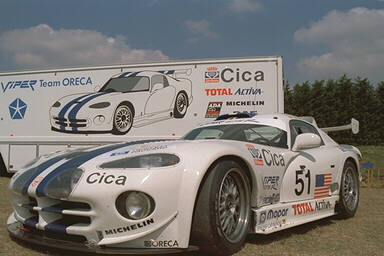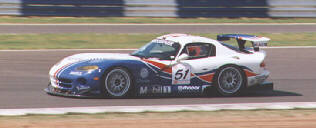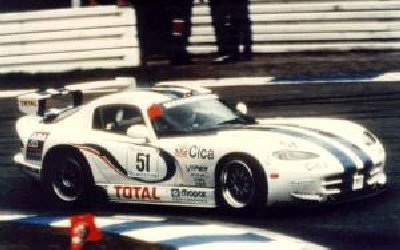Dodge VIPER GTS-R
Dodge Viper GTS-R
Can a professional wrestler compete in the
Olympics?
By DON SCHROEDER
It's mid-December at Atlanta Motor
Speedway, sunny but 45 degrees, and the wind is blowing briskly across the
infield of the big NASCAR oval. The temperature and low humidity suggest
that the big V-10 engine in the Viper coupe droning around the infield
track should have no problem cranking out its rated 650 horsepower, but it
isn't.
 Even though air is being rammed into this Viper's NACA hood
intake at speeds above 160 mph, the V-10 is gasping for air. Engineers
have discovered an unacceptable pressure drop across the race-prepared
engine's stock air filters. "The dyno won't tell you this stuff, which is
why we're here," says Viper engine chief Jerry Mallicoat. Even though air is being rammed into this Viper's NACA hood
intake at speeds above 160 mph, the V-10 is gasping for air. Engineers
have discovered an unacceptable pressure drop across the race-prepared
engine's stock air filters. "The dyno won't tell you this stuff, which is
why we're here," says Viper engine chief Jerry Mallicoat.
That "we"
also includes Viper engineer Gene Martindale, test drivers Neil Hannemann
(the 1994 SCCA World Challenge champion) and Tommy Archer (of Archer
Brothers fame on the Trans-Am circuit), and about two dozen other
technicians, engineers, and supplier and team representatives. The object
of their attention is the Viper GTS-R, a pure racing version of the Viper
GTS coupe that will run in three upcoming endurance races: the Rolex 24
Hours at Daytona in February, the Exxon Superflow 12 Hours of Sebring in
March, and the Le Mans 24-hour race in France this June.
The last
time Chrysler built a serious race car was in 1970, for the Trans-Am
series. Of five factory-prepared entries, the Dodge Challenger and
Plymouth Barracuda took the last two positions in points. Factory racing
has become much more sophisticated since then. And now Chrysler wants to
road-race its Viper. But wait. A big, burly, steel-framed V-10 Viper
battling the likes of the lithe McLaren F1 exoticar, which was
purpose-built for track racing? Or battling the Porsche 911 GT2, with more
than 30 years of factory-backed track experience? Are these guys missing a
few lug nuts?
Well, yes, sort of. The idea of a Viper as a race
car is every bit as bold as the idea, six years ago, of a street Viper,
approved for production when Chrysler didn't have any money and couldn't
even build a competitive sedan. Like the street car, the GTS-R is being
developed on a shoestring budget--just a few million dollars--and in
fast-forward time. There will be barely a year from GTS-R's approval to
its first trial-by-fire at the grueling Daytona 24-hour in February. The
changes required of the Viper to make a GTS-R are extensive. By the time
we looked at the car in mid-December--merely six weeks before its first
race--nearly all of the modifications had been carved in stone.

The rules that this GTS-R will
initially live under--FIA's, IMSA's, and ACO's GT class--require the GTS-R
to retain its original frame. Welded onto that frame is a stress-relieved,
4130 chrome-moly alloy steel spaceframe, which increases the torsional
stiffness of the frame to more than 18,500 pound-feet per degree, more
than double that of the upcoming production Viper coupe frame. The engine
and transmission are lowered 2.5 inches and set back 2.8 inches in the
frame for a lower center of gravity and improved weight distribution for
racing--about 47/53 percent front/rear on the GTS-R versus 49/51 percent
for the upcoming GTS coupe. Relocating the engine also allows frame
cross-bracing over and in front of the engine, and it gives more clearance
for the oil tank in the V-10's new dry-sump oil system.
For the
engine, that's just the start. The racing V-10s, assembled by Caldwell
Development, will be available in three forms. The standard "club" V-10
doesn't need many changes to make its 525 horsepower: just a racing
camshaft with more lift and duration, and Borla headers. The "endurance"
engine includes those changes, plus there's a velocity-stack intake
manifold with ported heads, solid-lifter roller rockers, higher-rate valve
springs, and chrome-moly Carillo connecting rods. Output is 650
horsepower. The "sprint" engine, at 700 horsepower, is an endurance engine
with larger valves, an even more aggressive camshaft, and valvetrain
changes that allow a higher 7000-plus-rpm redline. All three engines are
based on the '97 block design, which was lightened and strengthened with
new cast-in cylinder liners. Each optional engine will add about $30,000
to the GTS-R's expected $200,000 base price.
To boldly go where no
Viper has gone before, Chrysler welcomed many original-equipment suppliers
to its in-house effort. The transmission, for example, is a racing version
of the Viper's Borg-Warner T-56 six-speed. The rear differential is a big
Dana 60 with an aluminum case, specifically designed for the Viper GTS-R's
tremendous torque (more than 650 pound-feet on the optional engines). The
shock absorbers resemble Indy-car Konis, the steering rack is the Viper's
stock TRW with revised valving, and the brakes from Brembo are
whoppers--eight titanium pistons per caliper at the front, four-piston
calipers at the rear, grasping either carbon-fiber or cast-iron discs.
Michelin stepped in with custom Pilot SX racing slicks.
There's
also a Tilton carbon-fiber triple-disc clutch and eight-pound flywheel
(versus 32 pounds for the stock Viper). The center-lock three-piece BBS
wheels have cast-magnesium centers. Goodyear racing tires will also be
tested and offered.
All of this is wrapped up not by the Viper
coupe's 350-pound resin-transfer-molded body, but one done completely in
carbon fiber by Indy-car chassis builder Reynard, for a 200-pound weight
savings. The body sports a biplane-type rear spoiler that increases
downforce, although that will be changed to a single spoiler due to the
sanctioning-body rule changes.
Nice résumé. But does it work?
Chrysler wouldn't allow us behind the wheel to answer that question
because the GTS-R being tested was the only one in existence. With the
program timing already behind schedule, trashing the mule would mean . .
no program.
But we're sure that it has no problem going, stopping,
and turning. At Sebring, Chrysler did some preliminary tests with our
equipment and one of their drivers. With a stock transmission, an early
endurance engine, and a lousy launch, the GTS-R still leapt to 60 mph in
only 3.8 seconds. It continued accelerating as if a Saturn V booster were
strapped to the roof: 100 mph in 7.1 seconds, the quarter-mile in 11.5
seconds at 132 mph. Top speed should be over 200 mph, a velocity the car
could reach at Daytona or Le Mans.
Despite not being optimized for
such a dainty task, the brakes can haul the 2910-pound Viper from 70 to 0
mph in 148 feet. Around one 140-foot-radius curve, the GTS-R was managing
1.90 g of grip, with negligible downforce from the rear wing.
As
for its ability to get around the track, that's another story. The team
has been track-testing frantically for a number of months, undeterred by
weather, part failures, or even hawks crashing through the windshield at
140 mph (at Road Atlanta). At Sebring in early December, the car was
understeering excessively at speed, the rear end was
At Sebring in
early December, the car was understeering excessively at speed, the rear
end was bouncing too much, the shock valving was all wrong, and the car
was too hot inside. We asked 1995 Le Mans winner Andy Wallace, sitting in
the cockpit after testing, if the GTS-R was fun to drive, and there was a
pregnant pause, the result perhaps of years of talking to automotive
writers. "It will be," he replied. Another pause. "When it's right, it
will be fantastic fun," he added. Even the ever-smiling Martindale,
putting in six 12-hour days a week as engineering chief since the GTS-R
was approved, seemed weary.
And there was already good news. Driver
Hannemann says the GTS-R's handling is quite forgiving--a relief from a
car so closely related to such a brute-force street car. Just a few weeks
later at Atlanta, the GTS-R had improved considerably. The problems at
Sebring had mostly been solved, and the emphasis was now shifting toward
driveline durability. "On a scale of one to ten, at Sebring, I'd say we
were at four. Here at Atlanta, I'd call it a six or seven," said
Martindale.
Engine guru Mallicoat was more smiles, too. The engine
labs were reporting little wear from a recent teardown of the development
engine. Furthermore, the motor was running well with relatively lean
air-fuel ratios, meaning the GTS-R's Achilles' heel--uncompetitive fuel
economy--was being improved. More promising were the lap times at Atlanta
of under 1:19, exceeding the goals set by the team for the first
time.
Chrysler intends the first four GTS-Rs (built at the
company's new Conner Avenue assembly line in Detroit) to go directly to
two racing teams: Canaska-Southwind Motorsports in Toronto, for the
Daytona and Sebring events, and ORECA S.A. of France, for Le Mans.
Assuming those races go as planned, the company will then offer between 30
and 50 GTS-Rs at an expected base price of $200,000, roughly the same as
the Porsche but a steal compared with the nearly $1.1-million racing
McLaren F1 car. Chrysler plans to sell most of the cars to racing teams.
Second priority will be car collectors who want a piece of history. Good
history, the company hopes. For the GTS-R to even finish at Daytona would
be an accomplishment.
Critics have already tarred Chrysler's
efforts with its still-young sports car as quixotic, but that's a bit like
slagging the fat guy at the gym. The GTS-R is a remarkable display of
corporate determination. Even if it fails to make it out of the pits, the
engineers have already learned some lessons as a result of this program
that they will apply to the 1997 Viper. The stock '97 heads will be
derived from the GTS-R's, for example, and the block design has already
been strengthened by what the team has learned.
One thing's for
sure: Many eyes will be on this Viper in the next few months, and for once
it won't be because of that hot curvy
body.
|
